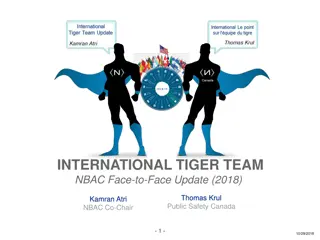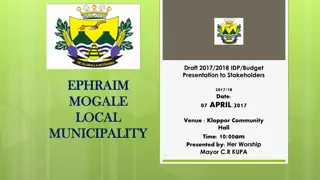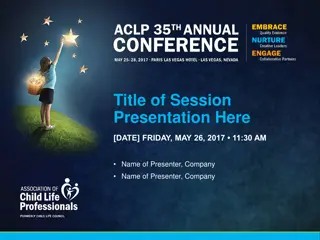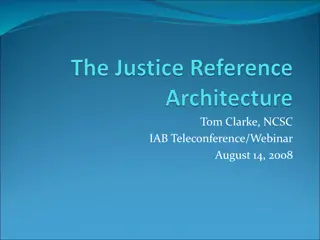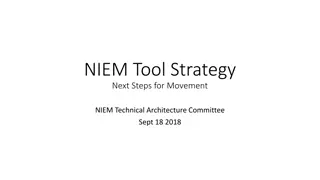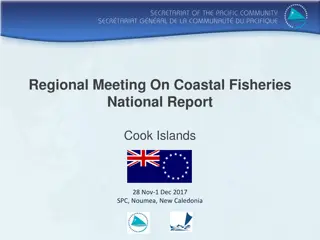
Enhancing Information Exchange with NIEM for Seamless Interoperability
Discover how NIEM (National Information Exchange Model) facilitates efficient information exchange across diverse organizations through a common vocabulary, saving time and costs while ensuring consistent meaning for data elements. Learn about NIEM core concepts, model overview, and its practical application for data interoperability.
Download Presentation

Please find below an Image/Link to download the presentation.
The content on the website is provided AS IS for your information and personal use only. It may not be sold, licensed, or shared on other websites without obtaining consent from the author. If you encounter any issues during the download, it is possible that the publisher has removed the file from their server.
You are allowed to download the files provided on this website for personal or commercial use, subject to the condition that they are used lawfully. All files are the property of their respective owners.
The content on the website is provided AS IS for your information and personal use only. It may not be sold, licensed, or shared on other websites without obtaining consent from the author.
E N D
Presentation Transcript
NIEM SIMPLIFIED I say vessel, you say boat, and she says conveyance. We mean the same thing, but we have no way to tell our computer systems to treat the words as having the same meaning. NIEM lets your system and my system speak to and understand each other, even if they ve never spoken before. NIEM ensures that information carries the same consistent meaning, allowing interoperability.
WHAT IS NIEM? NIEM is a common vocabulary that enables efficient information exchange across diverse public and private organizations. NIEM can save time and money by providing consistent, reusable data terms and definitions and repeatable processes.
THE BIG PICTURE: HOW NIEM WORKS NIEM is best for data in motion: it enables organizations to move information across organizational boundaries in order to interoperate and act as one, while maintaining authority of their own existing systems. Repeatable, Reusable Process (Information Exchange Development Lifecycle) Common Vocabulary (Community-driven Data Model) Built and governed by the business users at Federal, State, Local, Tribal, International and Private Sectors 4
DATA COMPONENTS The data model consists of two sets of closely related vocabularies: NIEM core and individual NIEM domains. NIEM core includes data elements commonly agreed upon across all NIEM domains, such as person, activity, location, and item. NIEM domains contain mission- specific data components that build upon NIEM core concepts. 5
MODEL OVERVIEW Think of the NIEM data model as a mature and stable data dictionary of agreed-upon terms, definitions, relationships and formats independent of how information is stored in individual agency systems. The data model consists of two sets of closely related vocabularies: NIEM Core and individual NIEM Domains. Agriculture (new in June 2017) Biometrics Chemical, Biological, Radiological, & Nuclear Emergency Management Human Services Immigration Infrastructure Protection Intelligence International Trade Justice Maritime Military Operations Screening Surface Transportation 6
NIEM IN ACTION: HOW NIEM EXCHANGES DATA COMPONENTS AND DATA ELEMENTS NIEM IS NIEM IS NOT a system or database; it does not specify how to transmit or store data. a common vocabulary that enables efficient information exchange across diverse public and private organizations. Using NIEM, organizations can come together to agree on a common vocabulary. When additional organizations need to be added to the information exchange, the initial NIEM exchange can be reused, saving time and money. 7
NIEM PROMOTES Collaboration Consistency Development Support NIEM brings stakeholders together through reuse and community engagement. NIEM provides consistency through reusable schema, which allows for many implementation options. Flexible and extendable, NIEM saves development time through agreed-upon elements, relationships, and formats independent of how information is stored in individual systems. New users can leverage what already exists and engage directly with other NIEM members for assistance. WHICH LEADS TO Lower Development Costs Enhanced Mission Capabilities Reduced Maintenance Costs Common Vocabulary 8
NIEMS GOVERNING STRUCTURE ESC Executive Steering Council The NIEM ESC serves as NIEM s decision-making body regarding membership, funding requirements, program or technical direction, personnel appointments, and other organizational decisions. NIEM PMO Executive Director The NIEM Executive Director and Program Management Office resources executes ESC s vision of NIEM while managing the day-to-day operations of NIEM. NTAC NBAC NIEM Business Architecture Committee NIEM Technical Architecture Committee The NBAC includes membership from all NIEM domains. Primary responsibilities include harmonization and issue resolution across NIEM core and individual domains. The NTAC defines the technical architecture associated with NIEM development and implementation as well as develops, implements, and maintains the technical specifications for the NIEM community. Feeds Business Requirements NIEM COMMUNITY Communities of people who share a common need to exchange information 9
NBAC OVERVIEW The mission of the NBAC is to set the business architecture and requirements of NIEM, manage NIEM core, and facilitate the processes for the regulation and support of NIEM domains. Provides management and oversight of the NIEM core, the central part of the NIEM data model that is commonly understood across all domains. NBAC NIEM Business Architecture Committee Co-Chairs PMO Liaison Assists new domains in onboarding to the NIEM community and promotes interactions between domains to collectively guide the NIEM community. Voting Members Lead Developers Observers/Invited Participants 10
NTAC OVERVIEW The mission of the NTAC is to define and support the technical architecture of NIEM. The NTAC documents, implements, and maintains technical specifications for NIEM. NTAC NIEM Technical Architecture Committee In addition, the NTAC is responsible for providing robust and effective development of the NIEM core structure and complementary processes to support and enable users to efficiently develop, use, and reuse NIEM-conformant model package description components. Co-Chairs PMO Liaison Voting Members Lead Developers Observers/Invited Participants 11
NIEM COMMUNITY STAKEHOLDERS The NIEM community continuously communicates with six different stakeholder types. Each stakeholder is interested in NIEM and how it can help its organization or project for different reasons Executives Program Managers Architects NIEM minimizes the time-to-market while allowing maximum flexibility. NIEM can make a job easier by helping teams build exchanges in less time, for less money time. NIEM offers a better way to exchange data and is adaptable; it can be modified or new capabilities added to an existing exchange. Developers Implementers Tool Providers Tools and support are available to make exchange development easier and faster. NIEM can lower the cost of maintenance in comparison to legacy formats. NIEM can be an avenue to connect with customers who have an interest in information sharing capabilities. 12
ENTRY/EXIT PROGRAM SUCCESS STORY Both Canada and the United States had a need to track land border crossings, so the two countries worked together to develop the Entry/Exit program confirmed entry into one country was considered exit from the other, helping both countries to track persons of interest, ultimately increasing public safety and security. 365 DAYS A YEAR NIEM was used to connect legacy systems and develop a common approach to data sharing. NIEM already contained the terms and definitions required for the exchange, allowing the teams from both countries to leverage the power of NIEM through reuse and quickly define the structure of the exchange. As a result of this project NIEM-based transactions are now flowing between the two countries 365 days a year. For future needs, this exchange could be reused or extended, saving time and money. 14
NATIONAL ELECTRONIC INTERSTATE COMPACT ENTERPRISE (NEICE) SUCCESS STORY In 2014, approximately 66,500 children were placed across state lines using the Interstate Compact on the Placement of Children. State child welfare agency staff must go through a time-consuming process to place these children in homes. The approval process averages 6-12 months, leaving the children in limbo, waiting for a stable, loving home. BEFORE To speed up this lengthy process, the National Electronic Interstate Compact Enterprise (NEICE) has been piloted, allowing state child welfare agencies to share this information and forms electronically. Within 2-3 weeks of launching the NEICE pilot, approvals that often took 6-12 months were taking 1-2 days, getting children into stable and loving homes sooner. Savings from eliminating printing and mailing costs alone were close to $1.6 million. NEICE + NIEM NIEM was the foundational data layer used to develop an electronic system for information exchanges between states. NIEM enables disparate child welfare data systems to exchange information on children and can be reused one exchange can be reused by all the states, saving time and money. 15
THE DRU SJODIN NATIONAL SEX OFFENDER PUBLIC WEBSITE SUCCESS STORY Previously, each state kept their own public record of known predators. This meant that if a known offender moved from one state to another, the public record in the new state would not reflect the known offender s new location across state lines. The Dru Sjodin National Sex Offender Public Website addressed the need to provide the public with access to sex offender information nationally, connecting known offender data across all 50 states, the District of Columbia, 4 US territories and over 100 Indian tribes, to one public- facing website. w w w = NIEM was used to develop information exchanges connecting state data to the national site. Now, with a single keystroke, concerned citizens can perform comprehensive searches on known sex offenders. With almost 2.5 million searches per month, the site helps us keep children and communities safer. CHILDREN PROTECTED ONE SITE 16
MORE ON NIEM www.NIEM.gov https://beta.movement.niem.gov GitHub NIEM.github.io LinkedIn http://www.linkedin.com/groups?gid=1903175 Twitter www.twitter.com/NIEMConnects YouTube www.YouTube.com/NIEMConnects 17
DISCLAIMER The use of the these materials in no way suggests or confirms the NIEM Program Management Office and its partners, endorse, support, favor, or approve of this end user s use. 18






